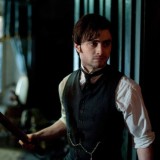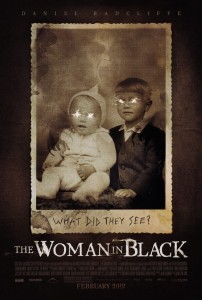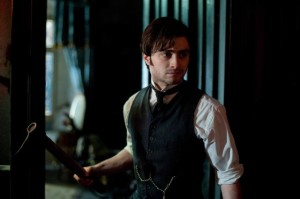
Movie Review: The Woman in Black
Having never seen a single Harry Potter movie, I was curious to see Daniel Radcliffe’s first major non-magician role, and while I was surprised at how well he portrayed the perpetually brooding widower, Arthur Kipps in The Woman in Black, I found the film itself to be a run of the mill ghost story full of familiar plot devices, flat characters, and underwhelming scares.

A long time ago a young filmmaker told me a movie that relies on lots of shots of the characters walking is generally not a good one; it is literally using the characters to physically move the story forward because the story isn’t strong enough to progress on its own. I never forgot that observation, and as the movie ended, I realized a good ten minutes of The Woman in Black was devoted to walking, and it was mostly of Kipps going from one room full of creepy old toys to another.
When Kipps isn’t out strolling, we are given brief glimpses of the village, Crythin Gifford, and the sad people who inhabit it. The place is sad, of course, because of the Woman in Black’s random and brutal killings of its children. While some of these scenes can achieve a hair raising effect, we are given no plausible reason, other than the death of her own child, as to why she exacts her revenge in this manner, nor does the film offer much back story of the village itself. Because of this lack of information about Crythin Gifford and the film’s antagonist, I found myself repeatedly wondering: If this angry spirit is killing children at random just because someone saw her, why not move?
Yet, despite its obvious downfalls, The Woman in Black does have a few redeeming qualities. The most obvious of which is Radcliffe’s turn as the broken protagonist. He does a terrific job of reining in the sympathy from the viewers with some truly heartfelt moments where his longing for a reunited family is both sincere and modest. For me, however, it was the period appropriate sets, costumes, décor, technology, etc. and the stunning landscapes which continued to catch my attention. The production team did a very nice job of dressing everything in a very authentic way and, at first, the bizarre amount of odd wind-up toys helped build tension for the film’s few memorable scares.
If you’re looking to see what Radcliffe has to offer as an actor in an unfamiliar role, then The Woman in Black is worth your time. But, if you’re looking for a terrifying thriller, let me leave you with this: Before the movie started I overheard several conversations in which people remarked, “I wish this was Harry Potter and the Woman in Black!” As the final and predictable scene played out, I couldn’t help but wish for that too.



